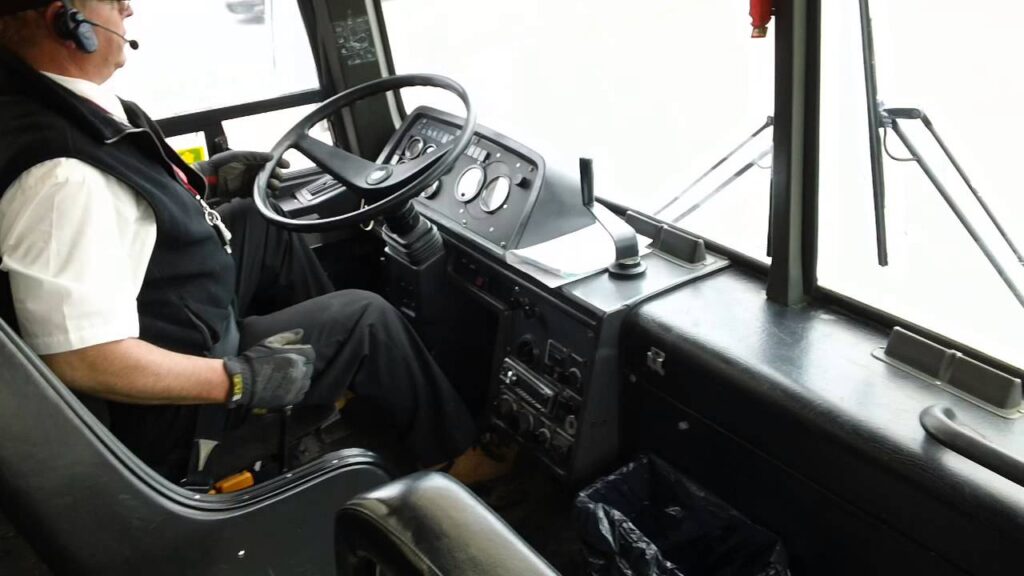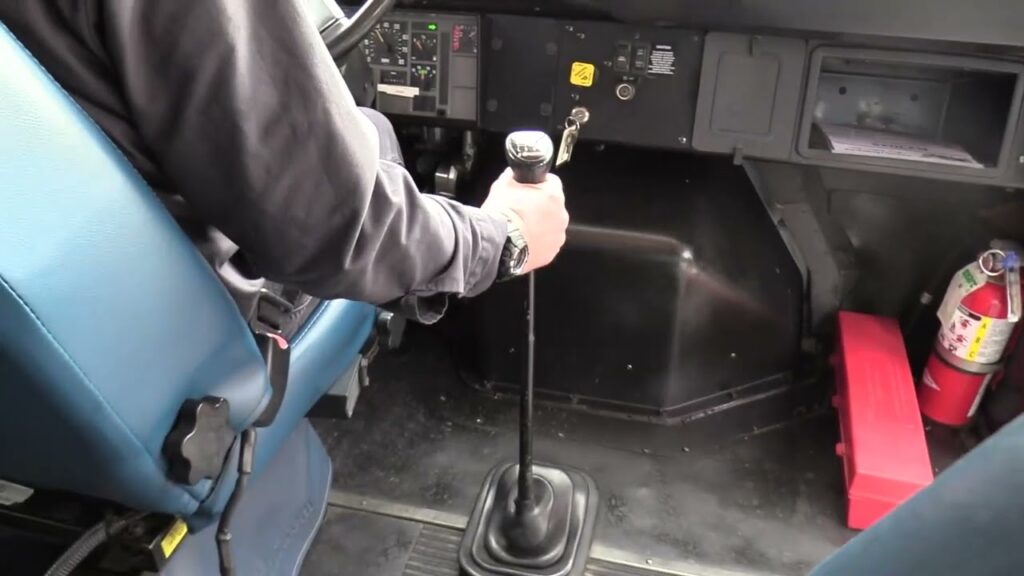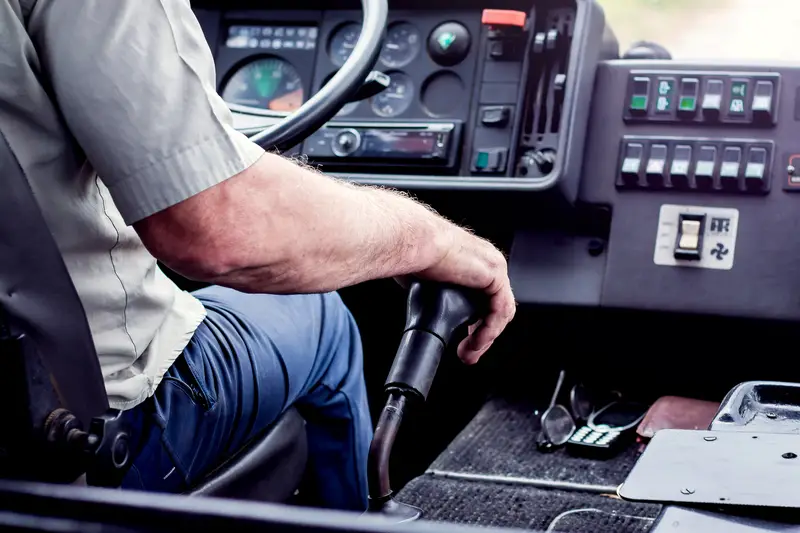Buses can have manual or automatic transmissions, with the choice depending on factors like manufacturer, usage, and regional preferences.
Manual transmissions require gear shifting by the driver, while automatic transmissions shift gears automatically. Many modern buses have automatic transmissions for smoother rides, while some feature semi-automatic systems that combine manual and automatic elements. The trend is toward automatic and semi-automatic transmissions for their convenience and efficiency.
What Are The Manual Transmissions in Buses?
Manual transmissions, also known as stick-shift or standard transmissions, require the driver to manually engage and disengage the gears using a clutch pedal and a gear lever.
In addition, the process involves coordinating the clutch pedal, gear lever, and accelerator pedal to smoothly shift gears. The driver’s skill and experience play a significant role in operating manual transmissions effectively.
Historical Prevalence of Manual Transmissions in Buses:
Manual transmissions were the standard choice for buses and other vehicles for a long time. In the past, automatic transmission technology was not as advanced as it is today.
Therefore, manual transmissions were commonly used in buses due to their simplicity and reliability. They were especially well-suited for larger vehicles with heavy loads and in regions where road conditions varied widely.
Reasons for Continued Use in Specific Cases:

- Cost Considerations: Manual transmissions tend to be less expensive to manufacture and maintain compared to automatic counterparts. Moreover, it makes them suitable for budget-conscious markets.
- Robustness: Manual transmissions can handle heavy loads and challenging terrains more effectively. Which is advantageous in certain types of bus applications, such as off-road or industrial use.
- Skill-Based Operation: Some regions may have a skilled workforce accustomed to manual transmissions, leading to their continued preference in those areas.
- Maintenance Simplicity: Manual transmissions have fewer complex components, making them easier and less expensive to repair and maintain, particularly in regions with limited access to advanced automotive technology.
Regional Preferences and Factors Influencing Choice:
- Geographical Factors: Regions with mountainous terrain or poor road infrastructure might favor manual transmissions due to their ability to provide better control in challenging conditions.
- Cultural and Market Factors: Some cultures may have a strong preference for manual transmissions due to tradition or a perception of greater control.
- Economic Considerations: In regions with limited financial resources, manual transmissions may be favored due to their lower initial costs and repair expenses.
- Technological Advances: As automatic transmission technology continues to improve, the need for manual transmissions diminishes, particularly in urban and high-traffic areas.
What Are The Automatic Transmissions in Buses ?
Automatic transmissions, also known as auto transmissions, are a type of gearbox that shifts gears automatically without requiring driver intervention.
Moreover, they use a combination of hydraulics, electronics, and mechanical components to control gear changes based on factors like vehicle speed, engine load, and throttle input.
In addition, automatic transmissions eliminate the need for a clutch pedal and manual gear shifting, offering a more user-friendly driving experience.
Advantages of Automatic Transmissions in Buses:
- Ease of Operation: Automatic transmissions simplify driving by removing the need for manual gear changes. In addition, this is particularly beneficial in heavy traffic and urban environments where frequent shifting can be tiring.
- Smooth Ride: Automatic transmissions provide seamless gear shifts, resulting in smoother acceleration and deceleration. Moreover, this contributes to passenger comfort and reduces jolts and jerks during travel.
- Reduced Skill Requirement: Drivers don’t need to master manual gear shifting techniques, which can attract a wider pool of drivers and potentially shorten training periods.
- Increased Efficiency: Modern automatic transmissions are engineered to optimize gear changes for fuel efficiency, ensuring the engine operates in its most efficient range.
- Enhanced Safety: With fewer distractions from shifting gears, drivers can focus more on the road and traffic conditions, improving overall safety.
Common Usage in Passenger Transport Buses:
Automatic transmissions are frequently used in buses designed for passenger transport, especially in urban and suburban settings.
Moreover, their ease of operation and smooth shifting make them well-suited for stop-and-go traffic and busy routes. Passenger comfort is a top priority in these applications, and automatic transmissions contribute to a more pleasant travel experience by minimizing abrupt gear changes.
Reduction of Driver Fatigue and Improved Comfort:
- Driver Fatigue: In long-haul routes or congested areas, manual gear shifting can be physically demanding and contribute to driver fatigue. In addition, automatic transmissions alleviate this strain by managing gear changes automatically.
- Comfort: Passengers experience fewer disturbances due to the absence of manual gear shifting. Moreover, the consistent and smooth acceleration provided by automatic transmissions enhances passenger comfort.
- Enhanced Accessibility: Automatic transmissions can be beneficial for drivers with physical disabilities or medical conditions that make operating a manual transmission challenging.
- Effortless Hill Climbing: Automatic transmissions excel in hilly terrain where frequent gear changes would otherwise be necessary. Additionally, this makes driving easier for the driver and more comfortable for passengers.
What Are The Current Trends and Future Outlook?

Shifting Preference Towards Automatic and Semi-Automatic Transmissions: There is a noticeable shift in preference towards automatic and semi-automatic transmissions in various vehicle types, including buses.
Moreover , this trend is driven by the desire for improved driver comfort, enhanced fuel efficiency, and technological advancements in transmission systems.
Factors Driving the Transition:
- Urbanization: As urban areas grow and traffic congestion increases, the convenience of automatic and semi-automatic transmissions becomes more appealing.
- Environmental Concerns: The pursuit of greener technologies and reduced emissions is encouraging the use of transmission systems that optimize engine performance and fuel efficiency.
- Evolving Consumer Expectations: Passengers and drivers now expect smoother rides and modern conveniences, which automatic and semi-automatic transmissions can provide.
- Advancements in Technology: Improvements in transmission technology have made automatic and semi-automatic systems more reliable, efficient, and cost-effective.
Potential Advancements in Bus Transmission Technology:
Hybrid and Electric Vehicles: With the rise of electric and hybrid buses, transmission technology is adapting to suit the unique characteristics of these vehicles.
Continuously Variable Transmissions (CVTs): CVTs, which provide a continuous range of gear ratios, could find more applications in buses to maximize fuel efficiency and provide seamless acceleration.
Integration with Vehicle Systems: Future transmissions might be more closely integrated with other vehicle systems, enhancing overall performance and efficiency.
FAQ’s
Why are manual transmissions still used in some buses?
Manual transmissions are cost-effective and robust, making them suitable for specific applications and regions with varying road conditions.
What benefits do automatic transmissions offer in buses?
Automatic transmissions provide ease of operation, smoother rides, improved fuel efficiency, and reduced driver fatigue.
What are semi-automatic transmissions in buses?
Semi-automatic transmissions combine manual gear selection with automated clutch control, offering smoother shifts and reduced driver effort.
How do automated manual transmissions (AMTs) work?
AMTs automate both gear changes and clutch engagement based on sensors, improving comfort and efficiency compared to manual transmissions.
Why are AMTs gaining popularity in buses?
AMTs offer a compromise between manual and automatic transmissions, providing easier operation, fuel efficiency, and reduced wear on components.
Conclusion
In conclusion, the world of bus transmissions is marked by a dynamic interplay between manual, automatic, semi-automatic, and automated manual systems.
Additionally, manual transmissions, historically prevalent and rugged, persist in specific cases due to their cost-effectiveness, robustness, and regional preferences.
However, the tide is turning towards automatic and semi-automatic transmissions, driven by their advantages of ease of operation, comfort, fuel efficiency, and safety.

